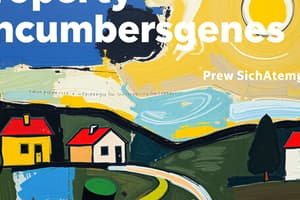Podcast
Questions and Answers
What should a buyer do if they notice utility poles on a property during their inspection?
What should a buyer do if they notice utility poles on a property during their inspection?
- Ask if the utility company has an easement. (correct)
- Ignore the poles as they are not recorded.
- Request the public records about the poles.
- Assume the poles indicate a sale.
What constitutes constructive notice by a property owner?
What constitutes constructive notice by a property owner?
- Visibly occupying or using the property. (correct)
- Photographing the property for evidence.
- Filing a claim in public records.
- Making verbal claims about ownership.
Is public record necessary for a utility company's easement rights to be valid?
Is public record necessary for a utility company's easement rights to be valid?
- Yes, it must be documented to be enforceable.
- Yes, it must be noted in property tax records.
- No, direct evidence can establish legal interest. (correct)
- No, but it must be mentioned in a contract.
What does the presence of utility poles on a property suggest?
What does the presence of utility poles on a property suggest?
Which of the following accurately describes constructive notice?
Which of the following accurately describes constructive notice?
What type of interest in property does an encumbrance represent?
What type of interest in property does an encumbrance represent?
Why might a property with encumbrances be less appealing to buyers?
Why might a property with encumbrances be less appealing to buyers?
How do encumbrances affect the ownership of property?
How do encumbrances affect the ownership of property?
What is one potential consequence of an encumbrance on property use?
What is one potential consequence of an encumbrance on property use?
What can influence whether or not a property transaction falls through?
What can influence whether or not a property transaction falls through?
What might be a seller's possible attitude towards encumbrances associated with their property?
What might be a seller's possible attitude towards encumbrances associated with their property?
Which of the following describes a concern buyers have regarding encumbrances?
Which of the following describes a concern buyers have regarding encumbrances?
Before purchasing property, what should buyers ensure regarding encumbrances?
Before purchasing property, what should buyers ensure regarding encumbrances?
What is the primary purpose of an easement?
What is the primary purpose of an easement?
Which of the following accurately describes a lien?
Which of the following accurately describes a lien?
What is a deed restriction?
What is a deed restriction?
How does a lease act as an encumbrance on a property?
How does a lease act as an encumbrance on a property?
What constitutes a cloud on the title?
What constitutes a cloud on the title?
What is one way to resolve a cloud on the title due to a potential claim?
What is one way to resolve a cloud on the title due to a potential claim?
Which of the following statements accurately describes a mortgage?
Which of the following statements accurately describes a mortgage?
What differentiates a license from an easement?
What differentiates a license from an easement?
Which encumbrance type is typically caused by local zoning laws?
Which encumbrance type is typically caused by local zoning laws?
What is a quitclaim deed primarily used for?
What is a quitclaim deed primarily used for?
Which scenario most likely results in a cloud on the title?
Which scenario most likely results in a cloud on the title?
Which type of encumbrance can be described as a restriction placed by the government?
Which type of encumbrance can be described as a restriction placed by the government?
What does an easement running with the land imply?
What does an easement running with the land imply?
How does a divorce potentially create a cloud on the title?
How does a divorce potentially create a cloud on the title?
What distinguishes an easement from a license in terms of duration?
What distinguishes an easement from a license in terms of duration?
Which of the following statements about encroachments is true?
Which of the following statements about encroachments is true?
What legal action can a neighbor take if an encroachment occurs?
What legal action can a neighbor take if an encroachment occurs?
What is a common type of encroachment?
What is a common type of encroachment?
What is one responsibility of a potential buyer regarding property encumbrances?
What is one responsibility of a potential buyer regarding property encumbrances?
What does constructive notice imply in property law?
What does constructive notice imply in property law?
Which situation exemplifies actual notice?
Which situation exemplifies actual notice?
What is one approach to resolving an encroachment rather than taking legal action?
What is one approach to resolving an encroachment rather than taking legal action?
What is an example of a document that needs to be recorded in the public record?
What is an example of a document that needs to be recorded in the public record?
What is NOT a characteristic of a license as compared to an easement?
What is NOT a characteristic of a license as compared to an easement?
What does the term 'encroachment' refer to?
What does the term 'encroachment' refer to?
What is a consequence for failing to properly file a claim on a property?
What is a consequence for failing to properly file a claim on a property?
What kind of survey is typically required when real estate is sold?
What kind of survey is typically required when real estate is sold?
What should a property owner do if they notice an encroachment?
What should a property owner do if they notice an encroachment?
Flashcards
Encumbrance
Encumbrance
A non-possessory interest in a property that burdens the title, affecting its clear ownership and potentially limiting its use.
Possessory interest
Possessory interest
An interest in property including the right to occupy and possess it, now or later.
Non-possessory interest
Non-possessory interest
An interest in property that does not include the right to occupy or possess it.
Encumbrances and property sales
Encumbrances and property sales
Signup and view all the flashcards
Title commitment review
Title commitment review
Signup and view all the flashcards
Unforeseen encumbrances
Unforeseen encumbrances
Signup and view all the flashcards
Easements and liens
Easements and liens
Signup and view all the flashcards
Property title transfer
Property title transfer
Signup and view all the flashcards
Constructive Notice
Constructive Notice
Signup and view all the flashcards
Easement
Easement
Signup and view all the flashcards
Utility Poles & Easements
Utility Poles & Easements
Signup and view all the flashcards
Public Records & Property Inspection
Public Records & Property Inspection
Signup and view all the flashcards
Inferring Legal Interests
Inferring Legal Interests
Signup and view all the flashcards
Lien
Lien
Signup and view all the flashcards
Deed Restriction
Deed Restriction
Signup and view all the flashcards
Lease
Lease
Signup and view all the flashcards
Cloud on Title
Cloud on Title
Signup and view all the flashcards
Quiet Title Suit
Quiet Title Suit
Signup and view all the flashcards
Quitclaim Deed
Quitclaim Deed
Signup and view all the flashcards
License
License
Signup and view all the flashcards
License vs. Easement
License vs. Easement
Signup and view all the flashcards
Easement vs. License
Easement vs. License
Signup and view all the flashcards
Easement Attachment
Easement Attachment
Signup and view all the flashcards
License Assignment
License Assignment
Signup and view all the flashcards
Encroachment Definition
Encroachment Definition
Signup and view all the flashcards
Common Encroachments
Common Encroachments
Signup and view all the flashcards
Resolving Encroachments
Resolving Encroachments
Signup and view all the flashcards
Encroachment Removal
Encroachment Removal
Signup and view all the flashcards
Identifying Encroachments
Identifying Encroachments
Signup and view all the flashcards
Recording Encumbrances
Recording Encumbrances
Signup and view all the flashcards
Title History
Title History
Signup and view all the flashcards
Buyer's Responsibilities
Buyer's Responsibilities
Signup and view all the flashcards
Actual Notice
Actual Notice
Signup and view all the flashcards
Constructive Notice Impact
Constructive Notice Impact
Signup and view all the flashcards
Property Ownership Notice
Property Ownership Notice
Signup and view all the flashcards
Study Notes
Encumbrances: Non-Possessory Interests
- Encumbrances are non-possessory interests in property that burden the title, affecting its clear title and potentially limiting owner use.
- They're attached to the title, not the owner, and may transfer with the property.
- Buyers generally dislike encumbrances, as they can limit property use and appeal.
- Unexpected encumbrances can hinder a sale.
Types of Encumbrances
- Easements: A right to use another's land for a specific purpose (e.g., shared driveway). They run with the land.
- Liens: Financial claims against property by creditors (e.g., mortgages, tax liens).
- Deed Restrictions (Restrictive Covenants): Private land-use controls limiting property use.
- Leases: Limit property owner's use; tenant does not own the title.
- Clouds on Title: Disputes clouding clear ownership; examples include unclear wills, divorce, or fraud.
- A quiet title suit resolves such disputes.
- Common causes include death without a will, divorce, or fraud. A quitclaim deed can resolve claims related to death or divorce.
- Other Encumbrances: Zoning regulations, environmental restrictions, and other less apparent limitations (height, dam conditions, subsurface rights) can affect property use.
Licenses vs. Easements
- Licenses: Temporary permissions to use another's land; revocable. They do not run with the land.
- Can be oral agreements, temporary, not permanently attached to the property, and are terminated by death or sale.
- Easements: Permanent rights to use another's land. They run with the land.
Encroachments
- Encroachments: Physical intrusions of one property onto another, often unintentional (e.g., fence, driveway, roof extending over the property line).
- Solutions: Negotiation, purchase of the encroaching portion, or lawsuit.
- Prevention: Property surveys are crucial to identifying encroachments during property transactions.
Notice and Title Searches
- Constructive Notice: Legal presumption that information is discoverable in public records (e.g., deeds). Property owners visibly occupying or using the property also give constructive notice.
- Actual Notice: Buyer has direct knowledge of an encumbrance through personal inspection or other means.
- Title Search: Essential to uncover encumbrances; a title company searches public records for such information.
- Survey: A physical inspection of the property is needed to detect encroachments.
Studying That Suits You
Use AI to generate personalized quizzes and flashcards to suit your learning preferences.

